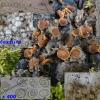
14-12-2012 21:32
Salvador TelloDe 0,2 mm, en madera seca de Ficus caria, pelos se

10-12-2012 20:33
 Björn Wergen
Björn Wergen
Hello everybody,unfortunately I have another stran

10-12-2012 22:28
 Christian Lechat
Christian Lechat
Dear friends, I would like to thank first all all

09-12-2012 18:11
Alain BRISSARDBonsoir à tousA nouveau confronté avec ces petit

10-12-2012 18:00
¡Hola a todos!Os presento este especimen: Perite
Asco place à feu
Patrice TANCHAUD,
12-12-2012 09:24
voici une récolte réalisée sur place à feu qui pourrait faire penser au genre Sphaerosporella, mais les spores ne sont pas rondes ... Apothécies jusqu'à 8 mm, asques 150-230 µm J-, spores 15,5-17 x 12-13 µm.
Pour le moment, je ne trouve rien pour avancer une détermination, merci d'avance pour les pistes éventuelles.
Patrice
Alain BRISSARD,
12-12-2012 14:33
Re : Asco place à feu
C'est vrai que cela ressemble bigrement à Sphaerosporella les spores n'étant pas parfaitement sphériques est-ce une anomalie ou pas?? les poils et les paraphyses ressemblent bien à ce que j'avais observé auparavant pour ce genre.
C'est tout ce que je peux en dire et je ne suis pas sur que cela te rassure. Attendons des réponses venant de spécialiste plus affutés que moi.
Alain
C'est tout ce que je peux en dire et je ne suis pas sur que cela te rassure. Attendons des réponses venant de spécialiste plus affutés que moi.
Alain
Patrice TANCHAUD,
13-12-2012 18:47
Re : Asco place à feu
Merci Alain, ta réponse montre au moins que mon message est bien passé. Ensuite, je dois bien avouer que je ne sais pas trop quoi penser de ma récolte. Peut-être un jour ... ???
Patrice
Patrice
Nicolas VAN VOOREN,
14-12-2012 08:31

Re : Asco place à feu
Je pense qu'il faut chercher dans le genre Trichophaea. Personnellement, j'irai du côté de T. contradicta.
Patrice TANCHAUD,
14-12-2012 09:10
Re : Asco place à feu
Bonjour,
avec ces spores elliptiques, je suis allé également vers le genre Trichophaea où je pensais avoir trouvé la solution moi aussi avec T. contradicta. Mais j'ai vu dans l'article suivant : DOUGOUD, R. (2004) Trichophaea contradicta (Seaver) H.J. Larsen. - Doc. Mycol. 132: 23-25., que les spores sont biguttulées et mesurent 16-17 x 11,2-11,6(12,2) µm. Mes spores sont un peu plus larges, c'est une chose, mais elles sont toutes uniguttulées, il m'a donc semblé difficile de retenir cette espèce.
Merci bien évidemment pour cette piste.
Patrice
avec ces spores elliptiques, je suis allé également vers le genre Trichophaea où je pensais avoir trouvé la solution moi aussi avec T. contradicta. Mais j'ai vu dans l'article suivant : DOUGOUD, R. (2004) Trichophaea contradicta (Seaver) H.J. Larsen. - Doc. Mycol. 132: 23-25., que les spores sont biguttulées et mesurent 16-17 x 11,2-11,6(12,2) µm. Mes spores sont un peu plus larges, c'est une chose, mais elles sont toutes uniguttulées, il m'a donc semblé difficile de retenir cette espèce.
Merci bien évidemment pour cette piste.
Patrice
Nicolas VAN VOOREN,
15-12-2012 10:02

Re : Asco place à feu
Effectivement, en reprenant les données détaillées de René et la publication de Seaver, ça ne peut pas correspondre. Reste deux hypothèses :
- un développement anormal de Sphaerosporella brunnea (qui, entre parenthèses, entre dans le genre Trichophaea) ;
- un taxon inédit... sous réserve d'éplucher la littérature !
- un développement anormal de Sphaerosporella brunnea (qui, entre parenthèses, entre dans le genre Trichophaea) ;
- un taxon inédit... sous réserve d'éplucher la littérature !
Patrice TANCHAUD,
15-12-2012 20:13
Re : Asco place à feu
La situation est bien résumée. Merci pour cette réponse.
Patrice
Patrice


